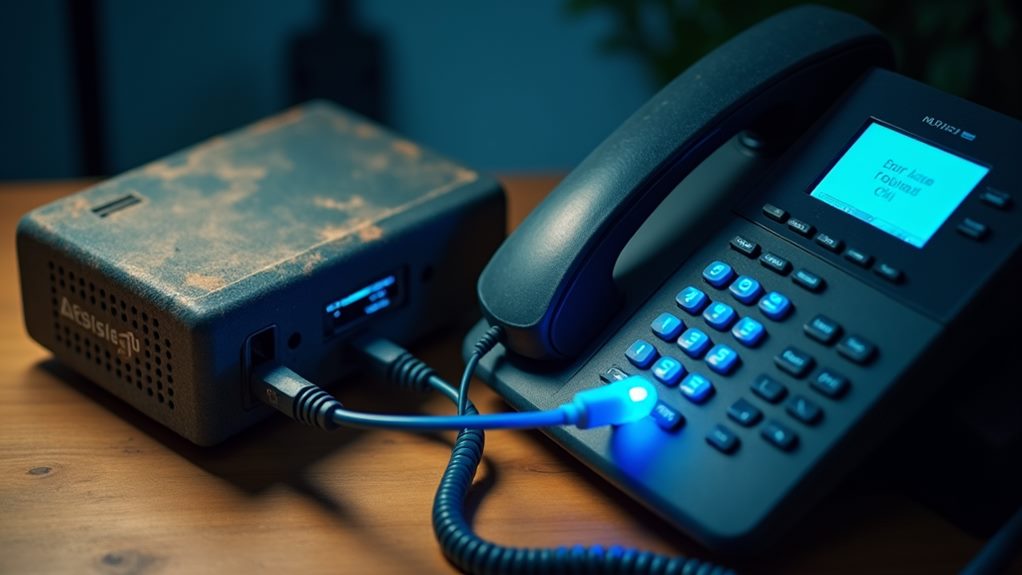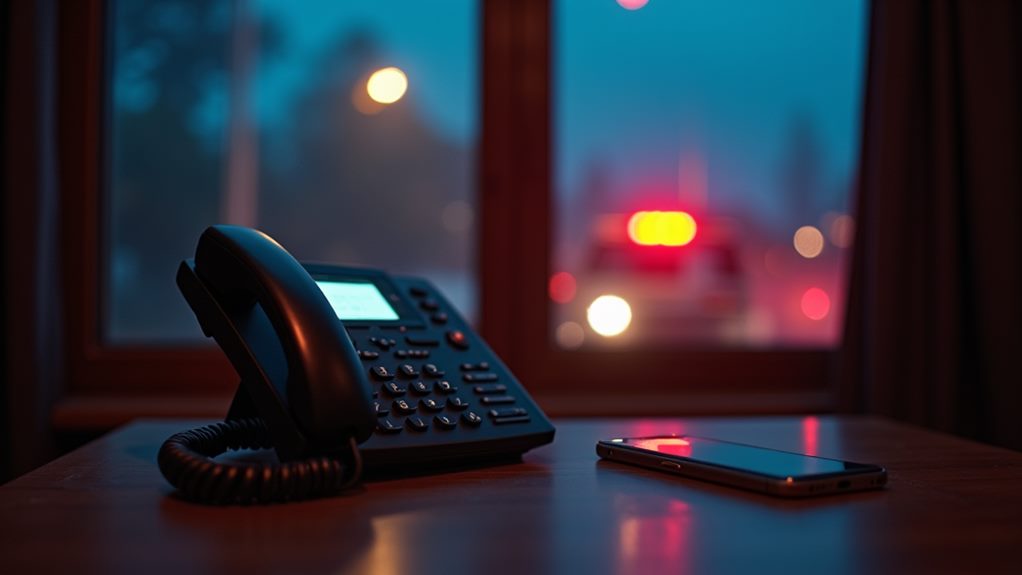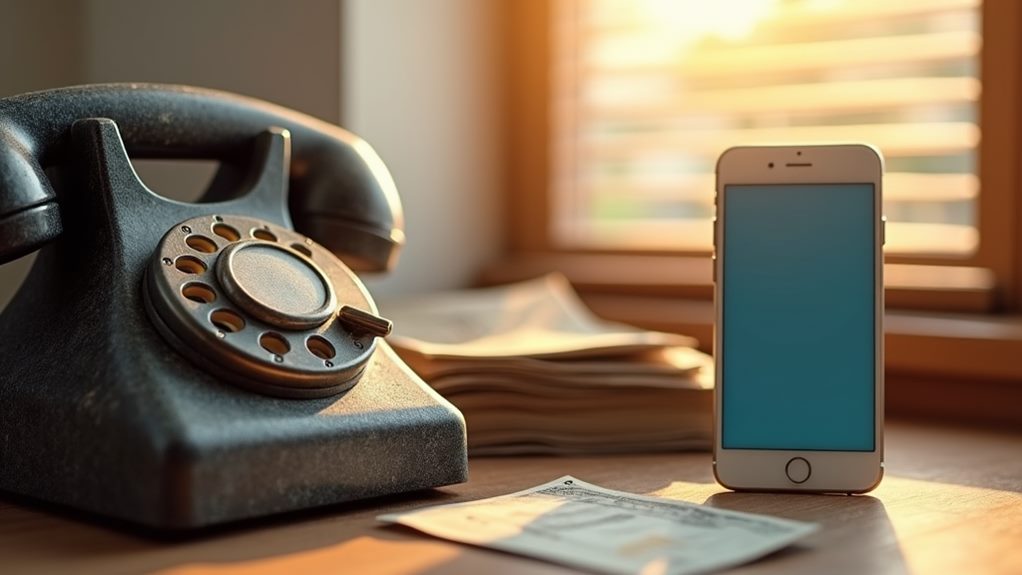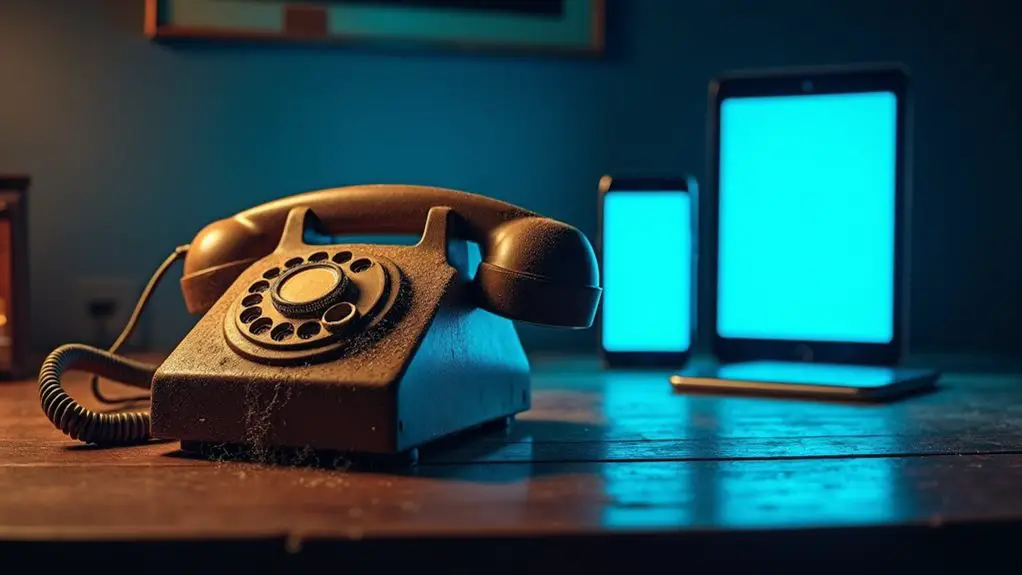Your landline service will switch from traditional copper-wire networks to digital Voice over Internet Protocol (VoIP) technology in 2025 as part of the UK's nationwide PSTN switch-off. You'll need a stable internet connection with at least 5Mbps broadband speed to make calls, and you can keep your existing phone number during the changeover. While the switch offers up to 50% cost savings and improved call quality, you'll require power backup solutions since VoIP relies on electricity. Major providers will supply necessary adapters and equipment, with special support systems for vulnerable users. Understanding the key requirements and changes will help guarantee your smooth changeover to digital phone service.
The Digital Phone Switch Explained

The Public Switched Telephone Network (PSTN), Britain's traditional copper-wire phone infrastructure, will undergo a transformative change in 2025. As businesses and homes shift to digital technologies, you'll witness the complete change from analogue landlines to digital Voice over Internet Protocol (VoIP) technology, marking a significant milestone in telecommunications history.
This change is poised to deliver cost savings of up to 50% compared to traditional landlines. As part of this nationwide digital upgrade, you'll need to guarantee your home or business has a reliable broadband connection. Your existing phone number won't change – providers will help you retain your familiar digits while upgrading your service to VoIP standards. You'll connect your current landline phone to your broadband router using an adapter that your provider will supply.
This digital switch brings you into a modern telecommunications network that offers enhanced capabilities. You'll experience improved call quality and gain access to advanced features like video calling and conference facilities.
The shift represents more than just a technical upgrade; it's your gateway to joining a more connected digital community. As the 2025 deadline approaches, you'll be part of this collective change toward a more capable and future-ready communications infrastructure that serves both residential and business needs.
Impact on Current Landline Users
Building on the digital switch rollout, current landline users face specific requirements to maintain their phone service beyond 2025. The shift to VoIP technology means you'll need a stable Internet connection to make and receive calls, fundamentally changing how your home phone operates.
With cost savings of up to 50% compared to traditional telephony and enhanced features available, adapting to this change may prove beneficial for many users. Your existing phone number can typically be retained, helping you maintain business and personal connections without disruption.
To guarantee a smooth shift, you'll need to verify these essential components:
- A reliable broadband connection that meets minimum speed requirements for VoIP service
- Compatible equipment, including potential adapters for existing phones
- Backup power solutions for maintaining service during power outages
- Updated emergency contact protocols aligned with digital systems
If you're currently using a traditional landline, your service provider will supply necessary equipment to connect your phone to the broadband router.
Special consideration is being given to vulnerable users, particularly elderly subscribers who may need additional support during the shift. The industry recognizes that this change represents a significant change in how you'll communicate, and providers are implementing extensive support systems to guide you through the process of adapting to this new digital telephone infrastructure.
Required Equipment and Internet Connection

Making the switch to VoIP-based landlines requires specific hardware components and a reliable internet infrastructure. You'll need a minimum broadband speed of 5Mbps to guarantee your VoIP phone functions properly, though higher speeds are recommended if you're sharing the connection with other users or devices.
Most providers will supply you with the required equipment, including an adapter that connects your existing landline phone to your broadband router. Additionally, VoIP technology fundamentals highlight the importance of using codecs for efficient voice communication, which is particularly relevant when selecting a provider.
To maintain your phone service after the PSTN switch-off, you'll need an active internet connection. If you're concerned about costs, providers will offer basic line-only broadband packages at prices comparable to current line rental fees. This assures you can stay connected without investing in high-speed internet plans.
Before making the change, it's important to verify the compatibility of any connected devices, such as telecare systems or security alarms, as these may need updates or replacement to work with the new digital system.
Your provider will guide you through the setup process, guaranteeing your VoIP phone service integrates seamlessly with your existing equipment and meets your communication needs.
Keeping Your Existing Phone Number
You'll be able to keep your current landline number when shifting to VoIP services during the 2025 PSTN switch-off, as providers have established streamlined porting processes.
Major telecom companies, including BT and Virgin Media O2, will automatically transfer your existing number to their Digital Voice platforms without interruption to your service.
If you're switching providers during the shift, you'll need to initiate the number porting request through your new service provider, who'll manage the transfer process on your behalf.
Number Transfer Process
The number transfer process during the 2025 landline switchover guarantees customers can maintain their existing phone numbers when shifting to VoIP services.
You'll benefit from an automated number porting system that seamlessly shifts your contact information from traditional analogue services to digital platforms.
The industry-standard porting process has been streamlined to guarantee business continuity and minimal disruption to your communications. When you're ready to make the switch, your new VoIP provider will handle the technical aspects of the transfer, making the shift straightforward and efficient.
Key aspects of the number transfer process include:
- Automatic porting for unported numbers during the switchover
- Retention of your established contact information across all services
- Provider-managed shift requiring minimal user intervention
- Seamless integration with new VoIP infrastructure
You'll maintain your professional identity and existing business relationships through this shift, as your current phone number follows you to the new digital platform.
This standardized approach to number porting guarantees you stay connected with your network while upgrading to modern communication technology, keeping you aligned with industry developments and maintaining your professional presence.
Digital Service Provider Options
Leading digital service providers offer extensive VoIP solutions that let you keep your existing phone number while upgrading your communication infrastructure. Major providers like BT, Virgin, Sky, and TalkTalk have streamlined the conversion process by implementing automatic number porting systems and supplying the necessary VoIP adapters for your existing phones.
You'll find significant flexibility in choosing your digital phone service provider, as the 2025 PSTN switch-off maintains your right to retain your original number regardless of which company you select. The shift to VoIP doesn't lock you into using the same provider for both phone and internet services, allowing you to optimize your communications setup based on competitive offerings.
Your provider will handle the technical aspects of number porting during the switchover, ensuring uninterrupted service as you move to the digital platform. The automatic porting process eliminates traditional transfer complications, making the switch more accessible for both residential and business users.
This seamless approach to number retention demonstrates how VoIP providers are prioritizing user convenience while modernizing the UK's telecommunications infrastructure.
Power Outages and Emergency Calls

You'll need to prepare for power outages affecting your digital landline service, as these modern systems require electricity to function, unlike traditional copper-wire phones.
Your ability to make emergency calls during blackouts depends on having a reliable backup power source, such as a battery unit provided by your telecom provider for vulnerable customers.
Maintaining alternative communication methods, including fully charged mobile phones, creates a critical safety net when your primary digital landline service experiences disruptions during power failures.
Emergency Power Backup Solutions
Modern digital landlines present a critical vulnerability during power outages, requiring robust backup power solutions to maintain emergency communication capabilities.
As you shift to digital services, it's vital to implement reliable backup systems that'll keep your communication lines active when traditional power fails.
To guarantee continuous access to emergency services, you'll need to evaluate your current setup and choose appropriate backup solutions:
- Battery backup units designed specifically for VoIP systems provide immediate power during outages
- Uninterruptible Power Supply (UPS) systems offer seamless shift between main power and backup power
- Dedicated backup solutions for telecare devices and security systems provide extensive protection
- Extended-duration batteries for vulnerable customers maintain critical communication links
When evaluating your backup power needs, consider the duration of typical power outages in your area and the specific requirements of your telecommunication devices.
You'll want to select a solution that provides sufficient runtime for emergency calls while supporting any additional connected devices.
Many providers now offer specialized battery backup options tailored to your specific setup, guaranteeing you're never disconnected from essential emergency services during critical moments.
Calling During Service Outages
Service disruptions present unique challenges for digital landline users during power outages, requiring a clear understanding of emergency communication protocols. When your digital landlines lose power, you'll need alternative methods to maintain essential communications, particularly for emergency situations. Without a battery backup unit, your VoIP systems won't function during outages, potentially leaving you disconnected when you need help most.
As part of our connected community, you'll want to guarantee you're prepared for service interruptions. If you're relying on digital landlines, consider these critical steps: install a battery backup system for your VoIP service, keep mobile devices charged and ready, and maintain a clear understanding of your provider's emergency protocols.
For vulnerable customers, you may qualify for provider-supplied battery backup units to maintain service during power outages.
You'll need to review your household's communication needs and develop a backup strategy. This includes evaluating your current setup, identifying potential failure points during power outages, and establishing redundant communication methods.
Battery Units Save Lives
Battery backup units serve as essential lifelines during power outages, enabling digital landline users to maintain access to emergency services when traditional power sources fail.
You'll find these units particularly important if you rely on VoIP systems or digital landlines for emergency communications, as they won't function during power cuts without proper backup power.
Your telecommunications provider should supply battery backup units if you're classified as a vulnerable customer. This guarantees you'll maintain the ability to make emergency calls when you need them most.
To maximize your safety and connectivity during outages, consider these important actions:
- Test your battery backup system monthly to verify its operational status
- Keep backup units properly maintained and charged
- Monitor battery life and replace units before they deteriorate
- Register with your provider as a vulnerable customer if you qualify
For those using telecare devices or medical alert systems, having a reliable battery backup becomes even more vital.
You'll want to implement a thorough backup power strategy that includes regular testing and maintenance schedules. This proactive approach guarantees you're never left without the ability to make emergency calls during critical situations.
Changes to Device Compatibility
Your existing landline devices will undergo significant compatibility changes as the Public Switched Telephone Network (PSTN) shifts to Voice over Internet Protocol (VoIP) in 2025.
You'll be glad to know that most of your current landline handsets will remain compatible with the new system, though you'll need an adapter to connect them to your broadband router.
Your service provider will supply the necessary adapters and equipment, guaranteeing you stay connected throughout the changeover. However, it's vital to verify the device compatibility of your specific handset model with your provider.
Your broadband router will become the central connection point for all voice services, replacing the traditional telephone socket.
If you're using telecare or security devices that rely on the analogue network, you'll need to take extra precautions.
These devices may require upgrades or replacements to function with VoIP technology. We recommend contacting your device suppliers well in advance to confirm compatibility and arrange any necessary updates.
This proactive approach will help guarantee all your communication systems continue operating smoothly after the switch-over, keeping you connected to your essential services and loved ones.
Cost Implications and Service Plans

During the 2025 digital switchover, most users will find their basic service costs remaining stable, with providers maintaining price parity between traditional landline rentals and new line-only broadband packages.
The change's cost implications have been carefully structured to guarantee minimal financial impact on existing customers, with major providers committing to seamless billing changes.
Key financial aspects you'll encounter during the switch include:
- Complimentary adapters from providers like BT, Virgin Media O2, Sky, and TalkTalk
- Consistent pricing structures aligned with current landline rental fees
- Enhanced VoIP features at competitive rates, particularly beneficial for business users
- No additional charges for standard service plan changes
Your service plans will likely offer improved value as VoIP technology delivers more features at optimized costs.
If you're using telecare services, you'll need to review your current plan with your provider to guarantee continued compatibility and determine if any equipment upgrades are necessary.
The shift to digital services represents a strategic move toward more cost-effective communication solutions, with providers focusing on maintaining affordable access while delivering enhanced functionality through modern infrastructure.
Support for Vulnerable Customers
Recognizing the diverse needs of at-risk populations, telecommunications providers will implement extensive support systems starting Spring 2025 to assist vulnerable customers through the digital switchover.
You'll find dedicated support through multiple channels as providers actively reach out to vulnerable customers to guarantee a smooth changeover. If you're using telecare services, you'll receive specialized attention through a coordinated effort between your provider and the Government. This includes thorough compatibility checks for your essential equipment and telecare devices.
For your peace of mind during power outages, major providers like BT and Virgin Media O2 will provide battery backup units to maintain your connection.
You won't be left to navigate these changes alone – over 120 Age UK branches will have specialized advisers ready to guide you through the process with expert knowledge and resources.
The changeover support program focuses particularly on elderly customers and those who might find the digital switch challenging.
You'll have access to personalized assistance, guaranteeing your specific needs are addressed and your essential communication services remain uninterrupted throughout the switch to digital landlines.
Final Thoughts
The landline sunset in 2025 will transform your traditional copper-wire service into an IP-based digital system, requiring both internet connectivity and backup power solutions. While you'll maintain familiar features like emergency calling and your existing number, you'll need to adapt to new VoIP equipment. The change represents a $1.7B infrastructure shift that'll phase out 99% of POTS lines, merging legacy voice systems with modern digital networks.

